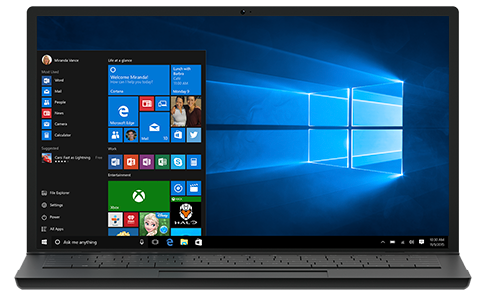How To Take Screenshots On Desktop Windows 10?
Capturing and sharing screen images is an essential skill in today’s digital age. Whether you need to document a software bug, create a tutorial, or simply preserve a memorable moment on your Windows 10 desktop, knowing how to take screenshots on desktop Windows 10 is a fundamental capability. Windows 10, the widely used operating system, offers several versatile methods to capture your screen effortlessly. From the classic “PrtScn” key to the modern Snip & Sketch tool, this article will walk you through the various techniques at your disposal. You’ll learn to capture the entire screen, specific windows, or even freeform areas with ease, ensuring that you have the right tool for every scenario.
In this article, we will explore the step-by-step instructions for each method, making it easier than ever to capture and share your screen content. So, whether you’re a tech-savvy professional or a casual user, mastering the art of taking screenshots in Windows 10 will undoubtedly enhance your computing experience.
Ways To Take Screenshots On Desktop Windows 10:
How To Take Screenshots On Desktop Windows 10 By Using The Snipping Tool Method:
To take screenshots on the Desktop using the Snipping Tool method, follow these steps:
Open the Snipping Tool :
You can open the Snipping Tool by searching for it in the Start menu. Type “Snipping Tool” and select the app when it appears in the search results.
Launch the Snipping Tool:
Once you’ve opened the Snipping Tool, you’ll see its window with various snipping options.
Choose the Snip Type:
Click on the “New” button in the Snipping Tool window. Then select from these four snip types:
Rectangular Snip :
By using this type of snip you can take a rectangular shape of the screen.
Free-Form Snip :
Capture a free-form area by drawing around it.
Window Snip :
Select a specific window or dialog box.
Full-Screen Snip :
This is used to take full capture. Capture the Screenshot: After selecting your snip type, use your mouse to select the area you want to capture. Once you release the mouse button, the snipped area will open in the Snipping Tool window.
Annotate and Save:
You can annotate the screenshot using the available drawing tools. When you’re satisfied, click “File” and select “Save As” to save the screenshot as an image file in your desired location.
Alternatively, Copy to Clipboard :
If you want to copy the screenshot to your clipboard without saving it as a file, click “Edit” and choose “Copy.”
Taking Screenshots On Desktop Windows 10 Using Snip & Sketch:
To take screenshots in Windows 10 using the Snip & Sketch method, follow these steps:
Capture a Screenshot:
When Snip & Sketch is open, a small menu will appear at the top of your screen.
Rectangular Snip :
This allows you to capture a rectangular portion of the screen.
Freeform Snip :
Capture a freeform area by drawing around it.
Window Snip :
Select a specific window or dialog box.
Full-Screen Snip :
Capture the entire screen.
Capture the Desired Area:
After selecting your snip type, use your mouse to select the area you want to capture.
Edit and Annotate:
You can use the Snip & Sketch editing tools to annotate or highlight parts of the screenshot. Click on the notification that appears after taking a screenshot to open the editing tools.
Save or Share:
You can paste the screenshot into an image editing program or document by pressing “Ctrl + V” or right-clicking and selecting “Paste.” From there, you can save the screenshot as an image file or share it as needed.
Using Snip & Sketch is a quick and efficient way to capture and work with screenshots on your Windows 10 desktop. It offers flexibility in choosing the type of screenshot you want to take and allows for easy annotation and sharing.
How To Take Screenshots On Desktop Windows 10 Using Print Screen (PrtScn) Key?
To take screenshots in Windows 10 using the Print Screen (PrtScn) key, you have a few options. The PrtScn key captures the entire screen, but there are variations of this method to capture specific parts of the screen. Here’s how to use the PrtScn key and its variations:
Capture the Entire Screen with PrtScn:
Locate the “PrtScn” key on your keyboard. It’s usually located in the upper-right area, often above the “Insert” and “Delete” keys.
Press the “PrtScn” key. This captures a screenshot of the entire screen and copies it to your clipboard.
Capture Only the Active Window with Alt + PrtScn:
To capture only the active window (the window currently in focus), press “Alt + PrtScn.”
Capture a Specific Area with Windows key + Shift + S:
To capture a specific area of the screen, you can use “Windows key + Shift + S.” This opens the Snip & Sketch tool.
Select the type of screenshot you want (rectangular, freeform, window, or full screen).
Capture the desired area, and the screenshot will be copied to your clipboard. Then you can easily paste it into the document or image editing program.
After capturing a screenshot using any of these methods, you can paste it into an image editor (e.g., Paint, Photoshop) or a document (e.g., Word, PowerPoint) and save it as an image file. Using the PrtScn key and its variations is a quick and simple way to capture and save screenshots in Windows 10.
Taking Screenshot On Desktop Windows 10 By Using Windows + Volume Down:
Taking a screenshot on a Windows tablet or 2-in-1 device using the “Windows key + Volume Down” key combination is straightforward. This method is particularly useful for devices that lack a physical keyboard. Here’s how to do it:
Locate the “Volume Down” button on your Windows tablet or 2-in-1 device.
Find the “Windows” button on your device, often located on the bezel or near the screen.
Simultaneously press and hold the “Windows” button and the “Volume Down” button.
Your screen will briefly dim or flash, indicating that a screenshot has been taken and saved
The screenshot is automatically saved in a folder within your device’s Pictures library. You can access your screenshots by opening the ”Screenshots” folder, which will be organized by date.
Taking a screenshot with the “Windows key + Volume Down” key combination on tablets and 2-in-1 devices is a quick and convenient way to capture your screen without the need for a keyboard. This method is especially handy for touch-based devices running Windows 10.
Using the Snipping Bar Method To Take Screenshots On Desktop Windows 10:
The Snipping Bar is a feature designed for Windows tablets or touchscreen devices, providing an easy way to capture screenshots. Here’s how to take screenshots using the Snipping Bar:
Swipe in from the right edge of the screen on your tablet or touchscreen device to open the Action Center.
In the Action Center, you’ll see various quick settings. Look for the “Screen Snip” button, which resembles a pair of scissors.
Tap on the “Screen Snip” button.
You’ll be presented with options to choose the type of snip:
Freeform Snip:
Capture a freeform area by drawing around it.
Window Snip :
Select a specific window or dialog box.
Full-Screen Snip :
Capture the entire screen.
Select the snip type you want and then capture the desired area by using your finger or a stylus on the touchscreen.
Once you’ve captured the screenshot, it will be opened in the Snipping Bar, and you can make annotations or highlight areas if needed.
You can save the screenshot as an image file or copy it to the clipboard for pasting into documents or image editing programs.
The Snipping Bar Is a convenient tool for touchscreen devices running Windows 10, allowing you to capture and work with screenshots easily. It offers a range of shipping options and provides flexibility for various screenshot needs.
Conclusion:
In conclusion, knowing how to take screenshots in Windows 10 is an invaluable skill for various purposes, from capturing important information to sharing memorable moments. Windows 10 provides several versatile methods to suit different needs, whether you prefer the classic “PrtScn” key, the feature-rich Snipping Tool, the modern Snip & Sketch tool, or the touchscreen-friendly Snipping Bar on tablets.
So, whether you’re a professional seeking to troubleshoot technical issues or a casual user looking to share content with friends and colleagues, taking screenshots in Windows 10 is a straightforward process that opens up a world of possibilities. With these tools at your disposal, you’re well-equipped to capture and share your digital world.







